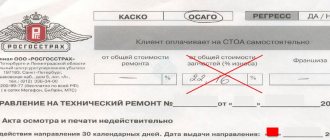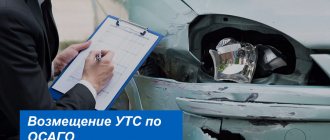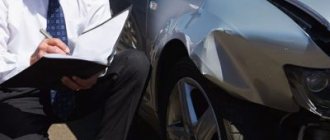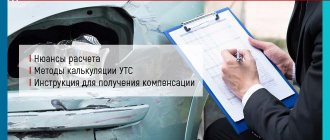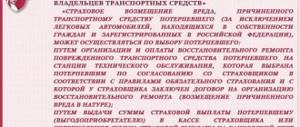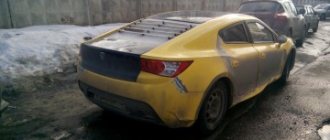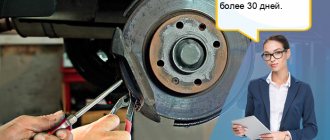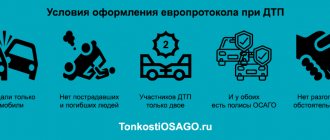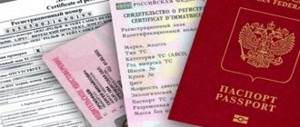- Characteristics of the accident scene inspection
- Legal basis for inspecting the scene of an incident
- General conditions for the production of weapons of mass destruction
- Recommendations for road accident participants
In this article we will talk about what an inspection of the scene of an accident is, explain the legal basis regulating it, and give practical recommendations for participants in the inspection.
The first action performed by a law enforcement official arriving to document a traffic accident is to inspect the scene of the accident.
An inspection of the scene of an accident is carried out with the participation of the parties, their representatives and other interested parties involved in it.
In order to achieve maximum efficiency in the implementation of the rights belonging to participants in a road accident during the proceedings on an accident, they need to know and understand the legal and essential nature of the inspection of the scene of the accident.
When and why is damage assessment required after an accident?
The purpose of assessing damages is to determine the amount that a victim of an accident can receive. Based on the characteristics of a particular accident, you can claim compensation in the following areas:
- actual damage to the car caused by a collision during an accident;
- loss of commodity value, i.e. reduction in market price due to replacement of parts or repairs;
- expenses incurred by the car owner for repair and restoration work (if the repair was made before applying for insurance or filing a claim against the culprit).
The obligation to fully compensate for damage follows directly from the provisions of the Civil Code of the Russian Federation. To protect the interests of road accident participants, the MTPL program is in place in Russia. It provides for the payment of compensation for the at-fault driver, but the amount of compensation is strictly limited.
To submit claims for damages, you need to calculate them correctly and accurately. To do this, you need to comply with traffic rules and Law No. 40-FZ “On Compulsory Motor Liability Insurance” already at the initial stage of document preparation, i.e. at the scene of the accident. Drivers must:
- fill out a notification of an accident yourself (according to the European Protocol), or with the involvement of a traffic police inspector;
- notify your insurer about the accident, submit a notice and present the car for inspection;
- obtain evidence of costs incurred for repairs, if permitted, before contacting the insurer.
Note!
When filling out the notice, you must indicate all visible damage to the car if it is related to the accident.
Hidden defects cannot be identified in this way, so the law obliges those involved in an accident to present the car for inspection to the insurance company. Each insurer has an agreement with auto experts and appraisers who conduct inspections, draw up conclusions and reports. Since insurance companies pay the victim with their own money, they have a direct interest in reducing the extent of damage. Therefore, damage assessment through insurer specialists is often biased. To protect the interests of the victim, the law allows for independent examinations and challenging the assessment results. You can find out more about all options for asserting your rights after an accident during a consultation with our lawyers.
How to contact your insurance company to inspect your car
After an accident, the victim needs to go to the insurance company as soon as possible. Which one is regulated by the MTPL Law:
An application for insurance compensation in connection with damage to the property of the victim is sent to the insurer that insured the civil liability of the person who caused the harm, and in the cases provided for in paragraph 1 of Article 14.1 of this Federal Law, an application for direct compensation for losses is sent to the insurer that insured the civil liability of the victim.
The owner should demand more than just an inspection of the car. This is just part of the process you need to go through to get insurance. It is necessary to notify the company that the vehicle has been in an accident. For this, the owner provides a package of documents:
- Statement. It is written in free form, but the insurance company may have standard forms that need to be filled out according to the sample.
- Notification of an accident.
It is formatted according to the standard. The owner of the car receives a notification form along with the policy. Both parties to the accident participate in filling out the document columns. - Passport. They also take a certified photocopy of it with them.
- Certificate about road accident. It is obtained from the traffic police. And if the incident was registered without the participation of service employees, this document is not needed.
- A copy of the accident report. The traffic police inspector who compiled the document gives it to the car owner.
There is no need to write a special application for a vehicle inspection. This stage is already mandatory during the registration of an insured event and receipt of payment.
Application for vehicle inspection
a special application for inspection of the vehicle . He contacts the insurer with a written claim for compensation and other documents regarding the accident listed in the MTPL Law. After this, the company is obliged to arrange an inspection of the vehicle no later than 5 days from the date of registration of the application.
If additional procedure is required to provide written confirmation of latent defects, a notice of defects must be submitted. It is drawn up in free form, for example, according to a sample.
Troubleshooting a car after an accident
Car inspection , carried out after an accident , is a detailed identification of the nature and extent of damage. It is performed by a specialist technician. Based on the results, an inspection card is drawn up, where individual flaws are included in each column. The result is a list of them, recommendations for eliminating defects, calculations of the price of materials, new parts and labor. Actually, this is the preparatory stage of car repair.
Troubleshooting a car after an accident
Drawing up an inspection report
Based on the results of the procedure, a document must be drawn up - an act. It is a form that must be filled out. Mandatory information included in the act:
- information about the car;
- date and place of the accident;
- reference number about it;
- information about the owner of the vehicle being examined or his authorized representative;
- a list of damaged parts and the nature of the breakdown of each of them;
- whether they can be replaced or repaired;
- Is there any hidden damage on the vehicle?
The act is completed with the signatures of the owner of the car, another participant in the accident, a representative of the insurance company, and the technician conducting the procedure.
The vehicle owner needs to carefully ensure that all defects acquired due to the accident are reflected in the document. Particular attention should be paid to the column about hidden damage. In most cases, insurers insist that they do not exist in a particular situation. The owner’s task is not to miss hidden damage, which may be evidenced by, for example, a poorly opening trunk or chipped coating on the inside of the body.
Expert opinion
Nadezhda Smirnova
Automotive Law Expert
At the end of the inspection, the car owner must receive a copy of the report so that the insurance company employees do not make changes to it later. If he does not agree with the results of the procedure, the document does not need to be signed.
How long is a vehicle inspection certificate valid?
The vehicle inspection report is valid until the victim receives compensation that suits him. Even if an additional procedure, an independent examination, is later carried out, the document can be used during legal proceedings. The act is valid and subject to review as long as there is a need for it. This period is not limited by law.
Methods for assessing damage
Even if drivers filled out a notice under the Europrotocol program and themselves determined the list of visible damages, they are still required to show the cars to their insurers. This requirement applies even to the culprit of the accident, who initially does not have the right to claim compulsory motor liability insurance. If the car owner does not present the car for inspection and assessment, he may lose the right to compensation for damage or face a recourse claim.
To obtain insurance
To receive payment under compulsory motor liability insurance, the damaged car must be submitted for inspection to the insurer's experts. Law No. 40-FZ prescribes that this must be done within 15 days. However, an insurance claim must be submitted within 5 days, so it is possible to fulfill both of these requirements at the same time. The action algorithm for assessing damage under compulsory motor liability insurance includes the following measures:
- each driver submits the car to his own insurance company;
- inspection of damage and calculation of damage is done by an expert who has entered into an agreement with the insurer;
- all parties can take part in the inspection of the vehicle;
- Based on the results of the inspection and calculations, conclusions and reports are drawn up indicating the amount of payments.
Important!
Despite the requirements of the law, most insurance company experts do not indicate loss of marketable value (LCV) in their reports.
Currently, the Central Bank of the Russian Federation is considering new rules for calculating the TCB, which will allow the majority of mutual claims to be removed. Until new rules are adopted, the loss of marketable value after an accident can be assessed through an independent assessment. The driver will receive a conclusion or report from the appraiser. If there are objections based on the results of the surveys or the calculation of the amount of payments, you can submit a claim to the insurer. To substantiate your claims, you must contact an independent expert, order a re-inspection and calculate the damage after an accident. This can be done both for a damaged car and a car that has undergone restoration repairs.
For recovery through court
Compensation through the court can occur in case of disagreement with the amount calculated by the insurer, or in direct recovery from the culprit. It is possible that the MTPL limit will be too small for full compensation. In this situation, you can submit to the court reports and conclusions drawn up during the inspection of the car by the experts of the Investigative Committee.
Typically, when filing a claim in court, the victim submits an appraisal report obtained through an independent appraiser. In order for this document to be recognized as appropriate evidence, it must be drawn up by a specialist who is a member of the SRO of appraisers and has a qualification certificate. Forms confirming expert status must be submitted along with the report.
To bring a claim against the culprit
You can file a claim for damages against the culprit of the accident if he did not have insurance, or the compulsory motor liability insurance limit is not enough to pay full compensation. When filing a claim, you must provide evidence of the extent of damage and an estimate of damages. To do this, the following nuances must be observed:
- if the victim contacted the insurance company before going to court, a report from the insurer’s appraiser can be attached to the claim;
- if the plaintiff orders an independent examination, he is obliged to notify the culprit of the accident about this (usually telegrams are used for this);
- the defendant has the right not only to present his objections and evidence, but also to insist on a re-evaluation with his participation.
Legal advice!
If at the time of going to court the repairs have actually been completed, keep all contracts, work orders, and payment documents.
The person at fault for the accident will probably want to reduce the amount of damage, so you must prove every penny in the calculation. The law does not limit the maximum amount of payments when assessing damage from an accident.
For example, if a newly purchased car is completely destroyed in an accident, the victim will receive almost all of its full value. In case of partial damage, standard and actual wear and tear, the cause-and-effect relationship of all damage and the consequences of the accident will be taken into account.
Law on compulsory motor liability insurance on provision of cars for inspection
The MTPL Law requires that a car damaged in an accident be presented for inspection:
In case of damage to property, in order to clarify the circumstances of the damage and determine the amount of losses to be compensated by the insurer, the victim intends to exercise his right to insurance compensation or direct compensation for losses, within five working days from the date of filing the application for insurance compensation and attached to it in accordance with According to the rules of compulsory insurance of documents, he is obliged to present the damaged vehicle or its remains for inspection and (or) independent technical expertise...
If the victim does not allow an insurance specialist access to the damaged car, the company has the right to refuse to pay for the damage. If it is impossible to deliver the vehicle to the site, this must be reported to the company so that the procedure can be organized elsewhere.
Power of attorney to inspect a car after an accident
A power of attorney to participate in the inspection of a car after an accident is issued by the owner of the vehicle to the person who will represent his interests during the procedure. The document, made according to the sample, is certified by a notary, and is drawn up no later than the day on which the application is submitted to the insurance company.
Based on this, a representative of the car owner can be present during the inspection of the car, ask the expert questions, express his disagreement, make comments, statements, demand clarification, etc.
Timing of inspection after an accident
Information on how much time is allocated for organizing and conducting a vehicle inspection is in the Law on Compulsory Motor Liability Insurance:
The insurer is obliged to inspect the damaged vehicle, other property or its remains and (or) organize their independent technical examination, independent examination (assessment) within a period of no more than five working days from the date of receipt of the application for insurance compensation or direct compensation for losses with attached documents...
The car must be provided for the procedure in the same condition in which it was left after the accident. The owner should under no circumstances rush to repair it himself.
The owner brings the wrecked car to a location where it can be inspected by a technician. He is notified of this in advance. And if the condition of the vehicle is such that it is impossible to overtake it, the procedure is carried out at its location. That is, where the tow truck took the wrecked car.
To learn about what documents are needed for insurance after an accident and the rules for inspecting a car by an independent expert, watch this video:
